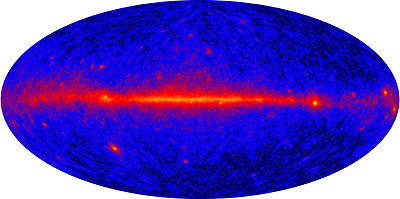NASA's newest observatory, the Gamma-ray Large Area Space Telescope (GLAST), has begun its mission of exploring the universe in high-energy gamma rays. The spacecraft and its revolutionary instruments passed their orbital checkout with flying colors.
Development of GLAST's gamma-ray tracker was led by a team of UC Santa Cruz physicists at the Santa Cruz Institute for Particle Physics (SCIPP) (see earlier press release). Robert Johnson, who led the SCIPP team, said the tracker, which includes nearly 900,000 active detection channels, is performing exceedingly well.
"The entire instrument is performing according to the design expectations," said Johnson, a professor of physics at UCSC. "The initial images illustrate well the enormous leap in capability of GLAST relative to previous instruments."
NASA announced today that GLAST has been renamed the Fermi Gamma-ray Space Telescope. The new name honors Enrico Fermi (1901-1954), a pioneer in high-energy physics. "Fermi was the first to suggest how cosmic particles could be accelerated to high speeds, and this work provides the foundation for understanding the powerful phenomena his namesake will observe," said Paul Hertz, chief scientist for science missions at NASA headquarters in Washington, D.C.
Scientists expect Fermi will discover many new pulsars in our own galaxy, reveal powerful processes near supermassive black holes at the cores of thousands of active galaxies, and enable a search for signs of new physical laws.
For two months following the spacecraft's June 11 launch, scientists tested and calibrated its two instruments, the Large Area Telescope (LAT) and the GLAST Burst Monitor (GBM). The LAT has already verified sources found by other gamma-ray detectors and discovered more.
The LAT team today unveiled an all-sky image showing the glowing gas of the Milky Way, blinking pulsars, and a flaring galaxy billions of light-years away. The map combines 95 hours of the instrument's "first light" observations. A similar image, produced by NASA's now-defunct Compton Gamma-ray Observatory, took years of observations to produce.
"The released images already show extraordinary flaring behavior of distant active galaxies," Johnson said. "Closer to home, the images illustrate gamma-ray pulsations from a neutron star, a topic of great interest to the UCSC group, which has long been developing tools for detection of new gamma-ray pulsars."
In the new image, gas and dust in the plane of the Milky Way glows in gamma rays thanks to collisions with accelerated nuclei called cosmic rays. The famous Crab Nebula and Vela pulsars also shine brightly at these wavelengths. These fast-spinning neutron stars, which form when massive stars die, were originally discovered by their radio emissions. The image's third pulsar, named Geminga and located in Gemini, is not a radio source and was discovered by an earlier gamma-ray satellite. Fermi is expected to discover many more radio-quiet pulsars, providing key information about how these exotic objects work.
A fourth bright spot in the LAT image lies some 7.1 billion light-years away, far beyond our galaxy. This is 3C 454.3 in Pegasus, a type of active galaxy called a blazar. It's now undergoing a flaring episode that makes it especially bright.
The LAT scans the entire sky every 3 hours when operating in survey mode, which will occupy most of the telescope's observing time during the first year of operations. These fast snapshots will let scientists monitor rapidly changing sources.
The instrument detects photons with energies ranging from 20 million electron volts to over 300 billion electron volts. The high end of this range, which corresponds to energies more than 5 million times greater than dental x-rays, is little explored.
The spacecraft's secondary instrument, the GBM, spotted 31 gamma-ray bursts in its first month of operation. These high-energy blasts occur when massive stars die or when orbiting neutron stars spiral together and merge.
"Our job is to see the whole sky and identify burst locations well enough to tell the LAT where to look," says Charles Meegan, GBM's principal investigator at NASA's Marshall Space Flight Center in Huntsville, Ala. "We're operational now, and as time goes on we'll get even better by reducing errors in the location measurement."
The GBM is sensitive to less energetic gamma rays (8,000 to 30 million electron volts) than LAT. Bursts seen by both instruments will provide an unprecedented look across a broad gamma-ray spectrum, enabling scientists to peer into the processes powering these events.
NASA's Fermi Gamma-ray Space Telescope is an astrophysics and particle physics partnership, developed in collaboration with the U.S. Department of Energy, along with important contributions from academic institutions and partners in France, Germany, Italy, Japan, Sweden, and the U.S.
More information, images and animations are available on the Fermi web site.
Note to reporters: You may contact Johnson at (831) 459-2125 or rjohnson@scipp.ucsc.edu.
Additional Media Contacts:
J. D. Harrington, NASA Headquarters
202-358-5241
j.d.harrington@nasa.gov
David Harris, Stanford Linear Accelerator Center
david.harris@slac.stanford.edu
650-926-8580
Lynn Cominsky, Sonoma State University
707-664-2655
lynnc@universe.sonoma.edu



